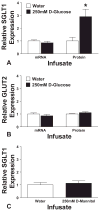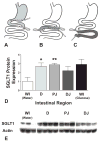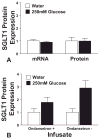Rapid upregulation of sodium-glucose transporter SGLT1 in response to intestinal sweet taste stimulation
- PMID: 20395849
- PMCID: PMC4123655
- DOI: 10.1097/SLA.0b013e3181d96e1f
Rapid upregulation of sodium-glucose transporter SGLT1 in response to intestinal sweet taste stimulation
Abstract
Objective: We set out to examine the short-term regulation of the intestinal sodium/glucose cotransporter SGLT1 by its substrate glucose and sweet taste analogs.
Summary background data: Intestinal SGLT1 is a putative target for antidiabetic therapy; however, its physiological regulation is incompletely understood, limiting its application as a pharmacological target. While it is clearly regulated by dietary composition over a period of days, its short-term regulation by nutrients is unknown.
Methods: Sprague-Dawley rats were anesthetized, and the duodenum cannulated. D-glucose, D-fructose, saccharin, D-mannitol, and water were infused for 3 hours, before harvest of proximal jejunum for SGLT1 analysis with Western blotting and quantitative polymerase chain reaction. In further experiments, the receptor region was identified by D-glucose infusion of isolated regions. Lastly, the vagus was de-afferented with capsaicin, and 5HT3-receptor activation of vagal afferents inhibited using ondansetron, before repeating experiments using water or D-glucose infusion.
Results: Infusion of D-glucose led to 2.9-fold up-regulation in SGLT1 compared with water or iso-osmotic D-mannitol; this effect was replicated by D-fructose or saccharin. This response was strongest following isolated infusions of duodenum and proximal jejunum, with a blunted effect distally; topography matched the expression profile of sweet taste receptor T1R2/T1R3. The reflex was abolished by capsaicin pretreatment, and blunted by ondansetron.
Conclusions: The agonist response implicates the luminal-based sweet-taste receptor T1R2/T1R3, with the reflex apparently involving vagal afferents. The proximal nature of the sensor coincides with the excluded biliopancreatic limb in Roux-en-Y gastric bypass, and this may provide a novel explanation for the antidiabetic effect of this procedure.
Figures





Similar articles
-
Intestinal sweet-sensing pathways and metabolic changes after Roux-en-Y gastric bypass surgery.Am J Physiol Gastrointest Liver Physiol. 2014 Sep 1;307(5):G588-93. doi: 10.1152/ajpgi.00405.2013. Epub 2014 Jul 3. Am J Physiol Gastrointest Liver Physiol. 2014. PMID: 24994857 Free PMC article.
-
Sweet taste receptor expression in ruminant intestine and its activation by artificial sweeteners to regulate glucose absorption.J Dairy Sci. 2014;97(8):4955-72. doi: 10.3168/jds.2014-8004. Epub 2014 Jun 2. J Dairy Sci. 2014. PMID: 24881785
-
T1R3 and gustducin in gut sense sugars to regulate expression of Na+-glucose cotransporter 1.Proc Natl Acad Sci U S A. 2007 Sep 18;104(38):15075-80. doi: 10.1073/pnas.0706678104. Epub 2007 Aug 27. Proc Natl Acad Sci U S A. 2007. PMID: 17724332 Free PMC article.
-
Nonruminant Nutrition Symposium: intestinal glucose sensing and regulation of glucose absorption: implications for swine nutrition.J Anim Sci. 2011 Jun;89(6):1854-62. doi: 10.2527/jas.2010-3695. Epub 2011 Jan 28. J Anim Sci. 2011. PMID: 21278108 Review.
-
[Role of the sweet taste receptor in glucose metabolism: no sweets for diabetes?].Yakugaku Zasshi. 2015;135(6):763-7. doi: 10.1248/yakushi.14-00250-1. Yakugaku Zasshi. 2015. PMID: 26028411 Review. Japanese.
Cited by
-
The β2-adrenergic receptor in the apical membrane of intestinal enterocytes senses sugars to stimulate glucose uptake from the gut.Front Cell Dev Biol. 2023 Jan 9;10:1041930. doi: 10.3389/fcell.2022.1041930. eCollection 2022. Front Cell Dev Biol. 2023. PMID: 36699012 Free PMC article.
-
Effects of Nonnutritive Sweeteners on Body Composition Changes during Pubertal Growth.Nutrients. 2023 May 15;15(10):2319. doi: 10.3390/nu15102319. Nutrients. 2023. PMID: 37242202 Free PMC article.
-
Sensing of amino acids by the gut-expressed taste receptor T1R1-T1R3 stimulates CCK secretion.Am J Physiol Gastrointest Liver Physiol. 2013 Feb 1;304(3):G271-82. doi: 10.1152/ajpgi.00074.2012. Epub 2012 Nov 29. Am J Physiol Gastrointest Liver Physiol. 2013. PMID: 23203156 Free PMC article.
-
Effects of Sucralose Ingestion versus Sucralose Taste on Metabolic Responses to an Oral Glucose Tolerance Test in Participants with Normal Weight and Obesity: A Randomized Crossover Trial.Nutrients. 2019 Dec 20;12(1):29. doi: 10.3390/nu12010029. Nutrients. 2019. PMID: 31877631 Free PMC article. Clinical Trial.
-
Glucose and fructose uptake by Limulus polyphemus hepatopancreatic brush border and basolateral membrane vesicles: evidence for Na+-dependent sugar transport activity.J Comp Physiol B. 2011 May;181(4):467-75. doi: 10.1007/s00360-010-0543-1. Epub 2010 Dec 24. J Comp Physiol B. 2011. PMID: 21184084
References
-
- American Diabetes Association. Economic costs of diabetes in the U.S. in 2007. Diabetes Care. 2008;31:596– 615. - PubMed
-
- Runge CF. Economic consequences of the obese. Diabetes. 2007;56:2668–2672. - PubMed
-
- Buchwald H, Avidor Y, Braunwald E, et al. Bariatric surgery: a systematic review and meta-analysis. JAMA. 2004;292:1724–1737. - PubMed
-
- Morton AP, Hanson PJ. Monosaccharide transport by the small intestine of lean and genetically obese (ob/ob) mice. Q J Exp Physiol. 1984;69:117–126. - PubMed
-
- Bihler I, Freund N. Sugar transport in the small intestine of obese hyperglycemic, fed and fasted mice. Diabetologia. 1975;11:387–393. - PubMed
Publication types
MeSH terms
Substances
Grants and funding
LinkOut - more resources
Full Text Sources
Other Literature Sources
Research Materials

